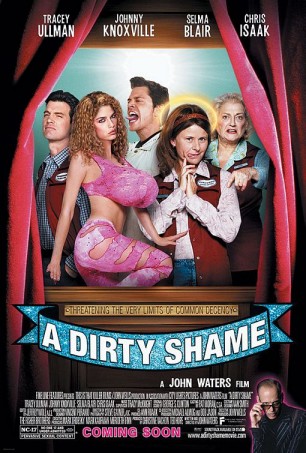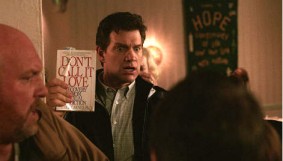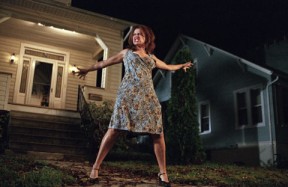|
A
Dirty Shame
John Waters, the self proclaimed Prince of Puke, has indeed
returned after a four year hiatus following his ode to cinema,
Cecil B. Demented. His latest endeavor is yet another
send-up of Douglas Sirk-style domesticity turned perversely
on its ear. The focus this time out is on the Baltimore
suburb Harford Road, an ultra-conservative community that
has an issue with sexual tolerance.
As with
most Waters vehicles, A Dirty Shame intends to
shock, excite, and most of all push the limits in all directions.
In this aim it does succeed; however it also manages to
accomplish something in the process. Though
Waters has denounced any desire to produce work that could
be labeled “socially redeeming” in the past,
the message here, although convoluted, is somewhat resonate.
Sylvia
Stickles (Tracie Ullman) lives up to her surname, as she
is indeed a stickler. She’s a working class mother
who manages to fix breakfast for her family before ushering
herself off to work her shift at the Pinewood Park and Pay,
a small gas station style convenience mart owned by Sylvia’s
mother Big Ethel (Suzanne Shepherd).
When
we first meet Sylvia, she is too busy “makin’
scrapple” to act on her husband Vaughn’s (Chris
Isaak) sexual appetite. This leads Vaughn to sneak off to
the bathroom with a copy of “Sex-Addict” magazine
to take matters into his own hands, as it were. This
sets up the entire dynamic for the rest of the film: desire,
repression, subversion, release. Though it sounds simplistic,
it really applies to so many levels.
We learn
that Sylvia's daughter Caprice (Selma Blair) is on house
arrest for excessive violations of indecent exposure laws.
Kept locked in her room, Caprice is "protected"
from her subversive lifestyle as an erotic dancer in a roadhouse
tittie bar. She prefers the name Ursula Udders, and it would
probably help to mention that she has inhumanly enhanced
breasts as well.
The
Stickles hide their shame. Their new neighbors from Washington
D.C., the Doggets, are aware of Caprice’s woes and
they get a good laugh when Ursula’s number one fan,
Fat F#ck Frank, shows up with hopes of spying Ursula’s,
well, Udders.
“Texture,
that’s what I call it” Wendell Doggett explains
as Frank insists on seeing Ursula. Ashamed of the whole
ordeal, Sylvia hops in the car and heads to work, leaving
her husband and co-worker behind to walk alone. On
her way to work, Sylvia crosses the paths of several of
her neighbors, each perceived to be a little odd, a touch
unfamiliar, and a bit frightening in some cases. Most notably
is the Bear Family, busy moving in down the street.
The
Bears are the three big, hairy, burly men moving boxes into
their new home in the trailer. They growl and paw at Sylvia
as she drives by, giving us the illusion that they are performing
some sort of lewd cat-call in her direction. She, of course,
is horrified. However, the Bear Family is not full of testosterone-blinded
chauvinists, but are instead a triumvirate of humble and
friendly gay sex addicts, unafraid of ridicule for their
lifestyle.
Perception
is key in both the film and in the Harford Road community.
Waters doesn’t trouble himself with a bothersome grey
area. Instead he paints in broad strokes here. Characters
are either sexually conservative or sexually addicted, and
they can be toggled between these two states with an accidental
concussion brought on by a simple bump on the head.
This
is, of course, exactly what happens to the ultra traditional
and sexually repressed Sylvia on her way to work, turning
her into a sexual monster of sorts. Waters uses bold labels
superimposed over characters as they switch sides, ranging
from “W-H-O-R-E” to “E-R-E-C-T.”
These
transformation sequences are punctuated with footage from
varied sources featuring horned devils, nude males and females,
and Santa Claus, just to name a few.
Sylvia’s
descent into sexual deviance and perversion of traditional
sexual practices provides the bulk of the staple gags and
gross out traits one would expect from Waters, but as always
the participants are all very normal, non-hollywood types,
mirroring the people we pass on the street every day. Waters
crams each frame full of sexual reference, turning the mise-en-scène
into an orgiastic explosion of sexual deviance and freedom
as he bullets through deviances spanning from the scatological
to infantilism to fetishes with filth. Yes, literally dirt.
Is it
ironic that a full service station worker named Ray-Ray
(Johnny Knoxville) is able to resuscitate a dead squirrel,
has a group of twelve sexually liberated followers, and
announces that he is “here to service you?”
No. He is Waters’ sexual savior, poking fun at the
religious right by offering them a glimpse of their direct
antithesis, the carnally indulgent.
Those
opposing the recent swarm of sex addicts are led by Marge
(Waters regular Mink Stole) and call themselves “Neuters.”
They claim that tolerance “went too far.” It
is also important to note that the Neuters are the ones
provoking repressive efforts, inciting the masses to revolt,
and have no qualms about selling them the tools needed to
rebel in the process.
Those
conservatives, always making a buck off of everyone else’s
turmoil...
In the
end, A Dirty Shame suffers from its own muddied
structure, as do many Waters vehicles. The barebones plot
only serves the purpose of delivering gag after gag. However,
this doesn’t hinder Waters’ goal. The film is
intended to call issues of sexual repression into question
and make audiences laugh in the process.
The
real dirty shame is that many may not get the joke.
Rating:

|









